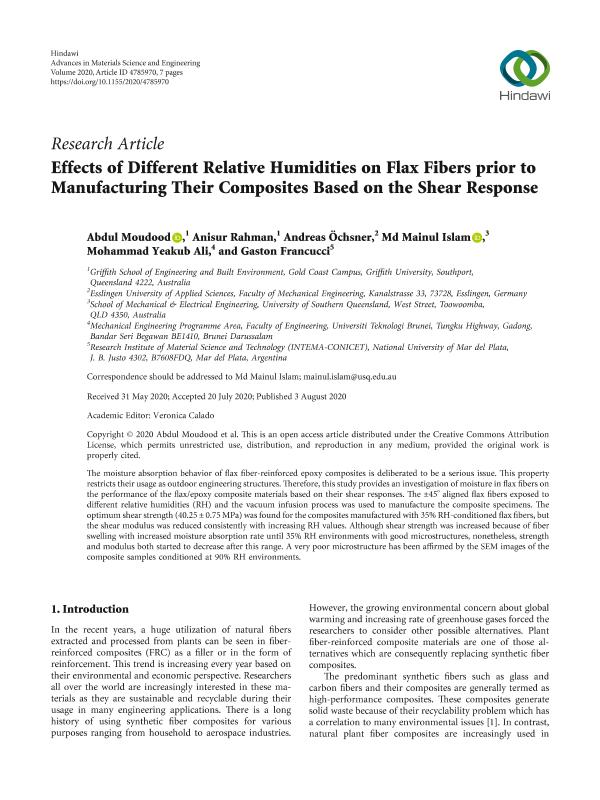Mostrar el registro sencillo del ítem
dc.contributor.author
Moudood, Abdul
dc.contributor.author
Rahman, Anisur
dc.contributor.author
Öchsner, Andreas
dc.contributor.author
Islam, Md Mainul
dc.contributor.author
Ali, Mohammad Yeakub
dc.contributor.author
Francucci, Gaston Martin

dc.date.available
2021-09-28T11:36:58Z
dc.date.issued
2020-08
dc.identifier.citation
Moudood, Abdul; Rahman, Anisur; Öchsner, Andreas; Islam, Md Mainul; Ali, Mohammad Yeakub; et al.; Effects of different relative humidities on flax fibers prior to manufacturing their composites based on the shear response; Hindawi Publishing Corporation; Advances in Materials Science and Engineering; 2020; 8-2020; 1-7
dc.identifier.issn
1687-8442
dc.identifier.uri
http://hdl.handle.net/11336/141672
dc.description.abstract
The moisture absorption behavior of flax fiber-reinforced epoxy composites is deliberated to be a serious issue. This property restricts their usage as outdoor engineering structures. Therefore, this study provides an investigation of moisture in flax fibers on the performance of the flax/epoxy composite materials based on their shear responses. The ±45° aligned flax fibers exposed to different relative humidities (RH) and the vacuum infusion process was used to manufacture the composite specimens. The optimum shear strength (40.25 ± 0.75 MPa) was found for the composites manufactured with 35% RH-conditioned flax fibers, but the shear modulus was reduced consistently with increasing RH values. Although shear strength was increased because of fiber swelling with increased moisture absorption rate until 35% RH environments with good microstructures, nonetheless, strength and modulus both started to decrease after this range. A very poor microstructure has been affirmed by the SEM images of the composite samples conditioned at 90% RH environments.
dc.format
application/pdf
dc.language.iso
eng
dc.publisher
Hindawi Publishing Corporation

dc.rights
info:eu-repo/semantics/openAccess
dc.rights.uri
https://creativecommons.org/licenses/by-nc-sa/2.5/ar/
dc.subject
Flax
dc.subject
Bio COmposites
dc.subject
Humidity
dc.subject
Degradation
dc.subject.classification
Compuestos

dc.subject.classification
Ingeniería de los Materiales

dc.subject.classification
INGENIERÍAS Y TECNOLOGÍAS

dc.title
Effects of different relative humidities on flax fibers prior to manufacturing their composites based on the shear response
dc.type
info:eu-repo/semantics/article
dc.type
info:ar-repo/semantics/artículo
dc.type
info:eu-repo/semantics/publishedVersion
dc.date.updated
2021-08-19T20:30:36Z
dc.journal.volume
2020
dc.journal.pagination
1-7
dc.journal.pais
Reino Unido

dc.journal.ciudad
London
dc.description.fil
Fil: Moudood, Abdul. Griffith University; Australia
dc.description.fil
Fil: Rahman, Anisur. Griffith University; Australia
dc.description.fil
Fil: Öchsner, Andreas. University Of Applied Sciences. Hochschule Esslingen; Alemania
dc.description.fil
Fil: Islam, Md Mainul. University Of Southern Queensland; Australia
dc.description.fil
Fil: Ali, Mohammad Yeakub. Universiti Teknologi Brunei; Brunéi
dc.description.fil
Fil: Francucci, Gaston Martin. Consejo Nacional de Investigaciones Científicas y Técnicas. Centro Científico Tecnológico Conicet - Mar del Plata. Instituto de Investigaciones en Ciencia y Tecnología de Materiales. Universidad Nacional de Mar del Plata. Facultad de Ingeniería. Instituto de Investigaciones en Ciencia y Tecnología de Materiales; Argentina
dc.journal.title
Advances in Materials Science and Engineering
dc.relation.alternativeid
info:eu-repo/semantics/altIdentifier/url/https://www.hindawi.com/journals/amse/2020/4785970/
dc.relation.alternativeid
info:eu-repo/semantics/altIdentifier/doi/http://dx.doi.org/10.1155/2020/4785970
Archivos asociados
